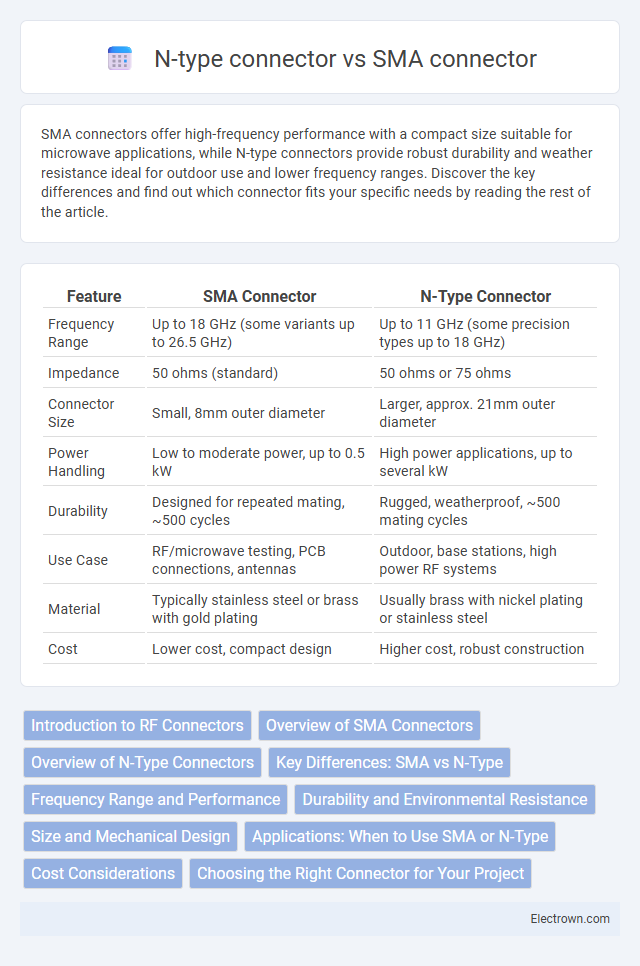SMA connectors offer high-frequency performance with a compact size suitable for microwave applications, while N-type connectors provide robust durability and weather resistance ideal for outdoor use and lower frequency ranges. Discover the key differences and find out which connector fits your specific needs by reading the rest of the article.
Table of Comparison
| Feature | SMA Connector | N-Type Connector |
|---|---|---|
| Frequency Range | Up to 18 GHz (some variants up to 26.5 GHz) | Up to 11 GHz (some precision types up to 18 GHz) |
| Impedance | 50 ohms (standard) | 50 ohms or 75 ohms |
| Connector Size | Small, 8mm outer diameter | Larger, approx. 21mm outer diameter |
| Power Handling | Low to moderate power, up to 0.5 kW | High power applications, up to several kW |
| Durability | Designed for repeated mating, ~500 cycles | Rugged, weatherproof, ~500 mating cycles |
| Use Case | RF/microwave testing, PCB connections, antennas | Outdoor, base stations, high power RF systems |
| Material | Typically stainless steel or brass with gold plating | Usually brass with nickel plating or stainless steel |
| Cost | Lower cost, compact design | Higher cost, robust construction |
Introduction to RF Connectors
SMA connectors are compact and ideal for high-frequency RF applications up to 18 GHz, offering excellent performance in small, precise environments. N-type connectors are larger, rugged, and support frequencies up to 11 GHz, making them suitable for outdoor and high-power RF systems. Understanding the differences helps you select the right connector for your RF transmission needs, balancing size, frequency range, and durability.
Overview of SMA Connectors
SMA connectors are precision-engineered RF connectors designed for high-frequency applications up to 18 GHz, featuring a threaded coupling mechanism that ensures secure and reliable connections. Their compact size makes them ideal for use in aerospace, telecommunications, and test equipment where space constraints are critical. You can expect excellent performance with low signal loss and high durability in environments requiring frequent connect and disconnect cycles.
Overview of N-Type Connectors
N-Type connectors are robust RF coaxial connectors designed for frequencies up to 18 GHz, providing excellent performance in high-power and outdoor applications due to their weatherproof design. Their threaded coupling mechanism ensures a secure and reliable connection, making them ideal for antennas, base stations, and microwave systems. You can rely on N-Type connectors for durability and stable signal transmission in demanding environments.
Key Differences: SMA vs N-Type
SMA connectors are designed for high-frequency applications up to 18 GHz with compact size, while N-type connectors support frequencies up to 11 GHz but offer superior durability and weather resistance, making them ideal for outdoor use. The threaded coupling of SMA connectors provides secure connections in tight spaces, whereas the N-type's larger, rugged design ensures stable performance in demanding environments. Your choice depends on the application's frequency requirements, space constraints, and environmental conditions.
Frequency Range and Performance
SMA connectors operate efficiently up to 18 GHz, making them ideal for high-frequency applications requiring precision and minimal signal loss. N-type connectors, conversely, support frequencies up to 11 GHz but excel in ruggedness and can handle higher power levels with stable performance. Your choice between SMA and N-type connectors should consider these frequency and performance characteristics to ensure optimal signal integrity in your RF systems.
Durability and Environmental Resistance
N-type connectors offer superior durability and environmental resistance compared to SMA connectors, featuring weatherproof designs that withstand harsh outdoor conditions and moisture exposure. SMA connectors, while smaller and suitable for high-frequency applications, have limited sealing capabilities, making them less ideal for rugged environments. Your choice depends on the need for robust durability and reliable performance in challenging weather conditions.
Size and Mechanical Design
SMA connectors are smaller with a compact design, typically 8 mm in diameter, making them ideal for applications requiring limited space and high-frequency performance up to 18 GHz. In contrast, N-type connectors are larger, usually around 21 mm in diameter, offering greater durability and weather resistance, suitable for rugged outdoor environments and frequencies up to 11 GHz. Your choice depends on balancing space constraints against mechanical robustness and environmental exposure.
Applications: When to Use SMA or N-Type
SMA connectors are ideal for high-frequency applications up to 18 GHz, commonly used in RF, microwave systems, and compact devices requiring precision and minimal signal loss. N-Type connectors are preferred in outdoor and industrial environments due to their rugged design, weatherproofing, and suitability for low-frequency to 11 GHz or higher in some precision models. Choose SMA connectors for small form factor equipment and high-frequency signal integrity, while N-Type connectors better serve heavy-duty installations and longer cable runs in wireless infrastructure and antenna systems.
Cost Considerations
SMA connectors generally offer lower cost solutions compared to N-type connectors due to their smaller size and simpler design, making them ideal for budget-conscious applications in high-frequency systems. N-type connectors, while more expensive, provide superior durability and better performance in harsh environments, justifying the investment for critical outdoor or industrial uses. Your choice between SMA and N-type connectors should balance initial expense against long-term reliability and environmental requirements to optimize overall project cost-effectiveness.
Choosing the Right Connector for Your Project
SMA connectors offer compact size and high-frequency performance up to 18 GHz, ideal for precision applications with limited space. N-type connectors provide robust durability and superior weather resistance, supporting frequencies up to 11 GHz, making them suitable for outdoor and heavy-duty environments. Your choice depends on project requirements like frequency range, environmental conditions, and mechanical stability to ensure optimal signal integrity and reliability.
SMA connector vs N-type connector Infographic

 electrown.com
electrown.com